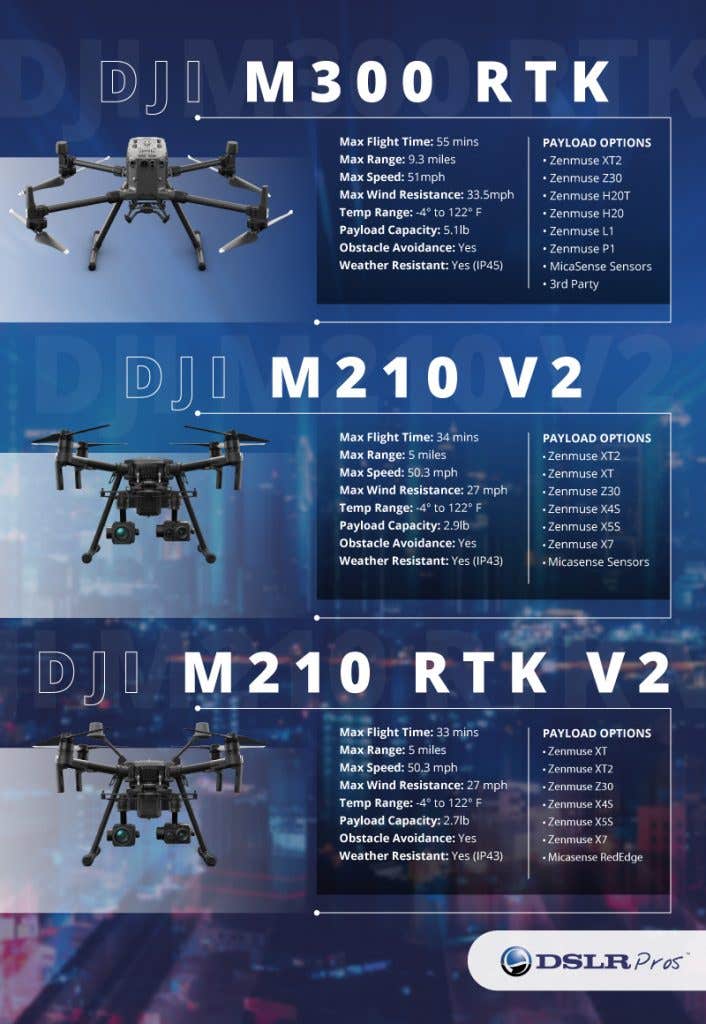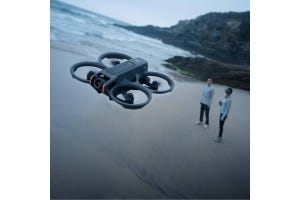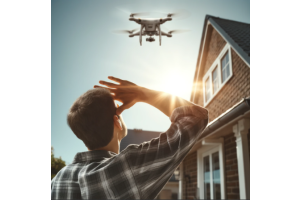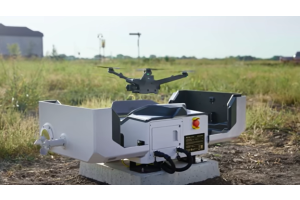
With the announcement of the DJI Matrice 300 back in May, people have been wondering what improvements DJI has made to the M210 model and which product best fits their needs. Each model features impressive specs with both their hardware and software. And both flight systems have an incredible amount of use applications. In this article, we will be taking a look at the differences between the M210 and the M300 and showing which unit is right for you.

Flight Time
Both the M300 and M210 Matrice models boast unloaded flight times over 30 minutes. But while the M210 is capable of 34 minutes of flight, the M300 can fly for 55 minutes without a payload. The drastically increased flight time of the M300 enables users to collect more data with less flights. For those who work in fire safety, search and rescue, or line inspection, longer flights are essential to safety and efficiency. But for those working in surveying or crop inspection, longer flight times may not be as necessary, nor worth the higher price tag.
With increased flight times comes the ability to cover a significantly greater distance. Of course, one can only fly as far as they can transmit and in this regard, the M300 again shows significant improvements over the M210. With a transmission range of 15 km, the Matrice 300 nearly doubles the M210’s 8 km range.
When flying missions over a large area or a small area with many waypoints, being able to fly for longer will make completing your survey or inspection easier and quicker. The long transmission range of the M300 also enables users to not have to move their take off location every time they change flight areas. For these reasons, we recommend the M300 to anybody who will be flying missions over a larger area.
Safety
The Matrice models have stunningly high Ingress Protection ratings (IP). This is a must for anybody piloting a system of this size and weight. The Matrice 210 has an IP of 43, offering protection against solid objects greater than 1mm in size and sprays of water up to 60 degrees off of the vertical.
With its increased IP of 45, the M300 has the same protection from solid objects AND protection against low pressure water jets. DJI claims that the M300 can fly in rains nearing a rate of 4 inches per day. Coupled with a maximum wind resistance of 15 m/s and it becomes clear that the M300 is a must for people who will be flying in conditions where wind and rain are a concern.

The Matrice 210 features an impressive array of inflight safety features including 3 directional sensors (top, bottom, and forward), top and bottom anti-collision beacons, and DJI’s AirSense software (to prevent collisions with other aircraft.) All of these features work together to create an amazingly safe flight system when in open air scenarios.
The M300 includes all of the above mentioned safety features but includes three additional directional sensors on the rear and sides. This allows you to know what is near your craft in all three dimensions and seems to be aimed at users who will be flying under and around structures like bridges and tunnels.

RTK Upgrading
RTK is a high precision navigation and positioning system that provides precise, centimeter level 3D positioning. This technology is invaluable for mapping and surveying. While both models are compatible with an RTK module, only the M300 can be upgraded later to use this technology. With the M210, you have to know when you purchase it if you will need RTK capabilities, and select the M210 RTK variant of the craft. The M300 offers users the freedom to decide later if they will need this, furthering the usefulness of the craft.
Payloads
The flight system itself is only one half of the equation for professionals who are looking to use a drone for industrial purposes. Equally important is the payload capabilities. While the Matrice 300 has a higher payload capacity of 2.7 kg compared to the M210’s 1.34 kg, both crafts have an impressive amount of possible camera configurations.
The Matrice 210 is capable of flying with a single gimbal on the bottom, two independent gimbals on the bottom, or a single gimbal on top of the craft.
In addition to all of these configurations, the Matrice 300 can also fly with one gimbal suspended below and one on top as well as two below and one on top.
Differences between these craft become more apparent when looking at the supported sensors and cameras. It is while looking at this that it becomes clear what DJI’s intended use cases are for each craft.
While both drones support the XT2 and the Z30, the Matrice 210 focuses primarily on gimbals with optical sensors for collecting high quality visual data. Flying a X7 gimbal on the M210 has become a reliable and well respected solution for professional surveying needs.
The supported gimbal systems for the M300 model skew heavily toward multi-imaging needs. The H20 and H20T gimbals are hybrid systems that offer a 20 MP zoom camera, a 12 MP wide angle camera, and an integrated Laser Rangefinder. The H20T goes one step further by including a Radiometric Thermal camera.

In addition to the H20 and H20T, DJI has recently announced the L1 and P1 payloads; both of which are only compatible with the M300 as of now. The L1 features state of the art Lidar imaging that allows for 3-D returns of large areas while an integrated RGB sensor provides color data for colorized point clouds or stand alone photogrammetry. The P1 is a dedicated photogrammetry sensor, utilizing a full frame camera to collect highly detailed image data for photogrammetry that allows for higher resolution images and covering larger areas than the L1. Both systems will be of great use for those working in construction, search and rescue, and public safety. By offering this variety of payloads exclusive to the M300, DJI seems to be intending the M300 for use cases that require high detail and more mapping capabilities than what is offered by the M210.

Looking at the payload capabilities of these crafts, it becomes clear that pilots working in agriculture or infrastructure inspection will be well served by the Matrice 210. This is especially true if they generally fly over smaller, low risk areas.
However, for those working in law enforcement, search and rescue, firefighting, or industrial inspection, the Matrice 300 is a game changer. The increased flight capabilities, safety features, greater variety of payload systems, and the ability to withstand wind and rain alike make the M300 a necessary part of high performance applications.
Both the M300 and M210 series of crafts are available at DSLRPros.com. Contact us for a quote today.





